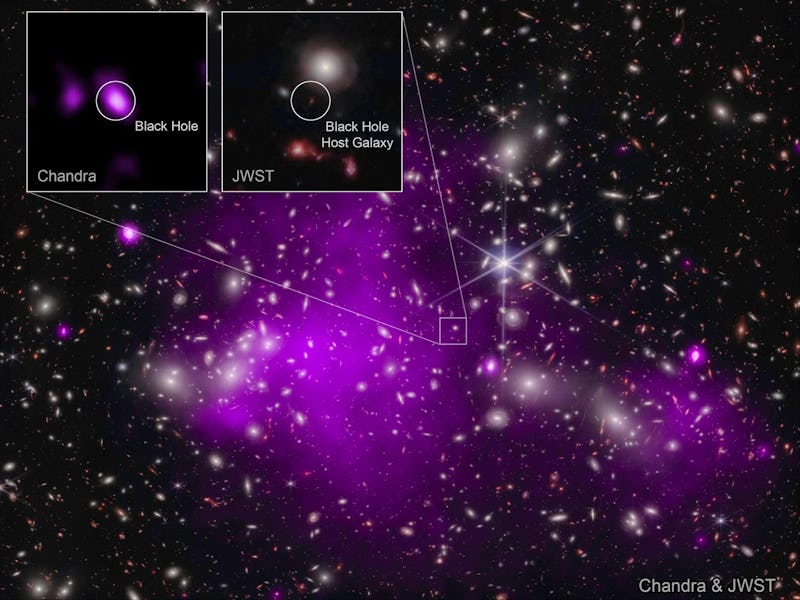Two Telescopes Spot the Oldest Black Hole Ever Discovered
The giant object lurking at the center of UHZ1 may be the first Outsize Black Hole we’ve ever discovered.

Astronomers have made a record-breaking discovery: a supermassive black hole churning and heating up unlucky matter when the universe was just 3 percent of its current age.
In a Monday announcement of the finding, NASA officials said that two space telescopes, which collected light from an incredibly faraway place 13.2 billion light-years from Earth, might be providing the best evidence for one way a supermassive black hole could originate so soon after the Big Bang.
The speed of light is finite, so the distant universe is also the ancient universe. The farther away an object is from Earth, the longer its light took to reach our telescopes, and therefore, the farther back in time the light originated. Galaxy UHZ1 is an incredible 13.2 billion light-years from Earth; the universe is 13.8 billion years old, for context.
This image reveals the Chandra and JWST data on the supermassive black hole at the center of galaxy UHZ1. It’s on the side of Abell 2744, a galaxy cluster boasting enough mass to warp and magnify the light coming from farther away.
In a new image, purple regions are places with hot gas from galaxy cluster Abell 2744, which, at 3.5 billion light-years from Earth, is much closer to us than the supermassive black hole highlighted in the middle of the image.
How Scientists Found This Supermassive Black Hole
The James Webb Space Telescope, a project from NASA, the European Space Agency, and the Canadian Space Agency, peered into Abell 244 because it’s a natural magnifying glass: This galaxy cluster has enough mass to bend the light from behind it, revealing the faint light beaming in from the ultra-distant galaxy UHZ1.
Then, NASA’s Chandra X-ray Observatory watched this object for two weeks. It detected X-ray light coming off high-energy activity as material whips around the supermassive black hole lurking at the center of UHZ1. It’s the most distant black hole ever seen in X-rays, according to NASA.
Supermassive black holes are thought to be at the heart of almost all galaxies. Their histories are essential to understanding how the universe evolved into what we see today. Black holes are forged in the collapse of stars. So, if the early universe didn’t have a plethora of stars to create black holes, how could they form so massively and so soon after the Big Bang?
The supermassive black hole from UHZ1 is colossal, weighing somewhere between 10 and 100 million Suns, just about as much as the mass of all the stars inside the galaxy itself. That’s hugely different from the ratios we see in modern galaxies. Those in the nearby universe “usually contain only about a tenth of a percent of the mass of their host galaxy’s stars,” according to NASA.
This New Discovery May Be An Outsize Black Hole
There might be an explanation. In 2017, Yale University astrophysicist Priyamvada Natarajan, who is a co-author of the new study describing the findings, proposed a theoretical model. In it, supermassive black holes in the early universe form when a huge cloud of gas collapses, resulting in what Natarajan calls an “Outsize Black Hole.”
“We think that this is the first detection of an ‘Outsize Black Hole’ and the best evidence yet obtained that some black holes form from massive clouds of gas,” Natarajan said in NASA’s statement. “For the first time we are seeing a brief stage where a supermassive black hole weighs about as much as the stars in its galaxy.”
A paper with a deeper investigation into this galaxy and the Outsize Black Hole premise is forthcoming, according to NASA. But the new revelation from Chandra and JWST show that the science of the ancient universe is coming into reach.